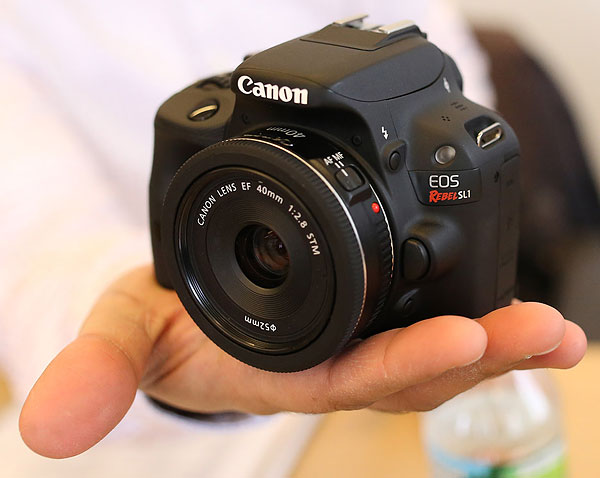Adobe Lightroom, Camera Raw updates tune Fuji algorithms, support new cameras in record time
posted Thursday, April 4, 2013 at 1:19 AM EDT

In late February, Adobe issued release candidate versions of updates for its Photoshop Lightroom, Photoshop Camera Raw, and DNG Converter applications that offered refined support for Fujifilm X-Trans based cameras, squashed a number of bugs, and extended support for new camera bodies and lens profiles. Those release candidates have now been made final, and there are quite a few changes from the release candidates. (If you're keeping tabs, we've marked these in italics throughout this item.)
The most significant changes come for Fujifilm shooters. As well as the earlier refinements to X-Trans conversion, which have been further tunes, Adobe has also increased sharpening defaults for two cameras, and improved its demosaicing algorithms for a further ten cameras based on EXR sensors. Changes for the latter apply only when working on files shot in EXR HR mode.
There are also 25 newly-supported cameras and camera backs, all but nine of them added since the release candidates. Impressively, this includes both the recently-announced Canon SL1 and Canon T5i, just two weeks after they were first unveiled. In addition, there are twelve newly-profiled lens types, with three from Tamron being additional to those from the release candidates. And a total of seven Camera Raw and 11 Lightroom issues are corrected, all of them noted previously in the release candidate versions.
In full, the list of cameras newly supported by Lightroom 4.4, Camera Raw 7.4, and DNG Converter 7.4 includes (with newly-supported models in italics):
-
Canon EOS-1D C
-
Canon EOS Rebel SL1 (aka EOS 100D / EOS Kiss X7)
-
Canon EOS Rebel T5i (aka EOS 700D / EOS Kiss X7i)
-
Casio Exilim EX-ZR700
-
Casio Exilim EX-ZR710
-
Casio Exilim EX-ZR750
-
Fujifilm FinePix F900EXR
-
Fujifilm FinePix HS50EXR
-
Fujifilm FinePix SL1000
-
Fujifilm X100s
-
Fujifilm X20
-
Hasselblad H5D-40
-
Hasselblad H5D-50
-
Hasselblad Lunar
-
Leica M (Typ 240)
-
Nikon Coolpix A
-
Nikon Coolpix P330 (preliminary support)
-
Nikon D7100
-
Nikon 1 J3
-
Nikon 1 S1
-
Olympus XZ-10
-
Pentax MX-1
-
Samsung NX300
-
Sony Alpha NEX-3N
-
Sony Alpha SLT-A58
Additionally, the demosaicing algorithms used for Fujifilm cameras based on the X-Trans and EXR sensors have been improved, and default white balance has been tweaked for various Nikon cameras. In all, cameras with updated algorithms include (with newly-tweaked models in italics):
-
Fujifilm X-Pro1 (sharpening level increased from release candidate)
-
Fujifilm X-E1 (sharpening level increased from release candidate and default aspect ratio corrected)
-
Fujifilm X-S1
-
Fujifilm X100S
-
Fujifilm X10
-
Fujifilm X20
-
Fujifilm XF1
-
Fujifilm FinePix F550EXR
-
Fujifilm FinePix F600EXR
-
Fujifilm FinePix F770EXR
-
Fujifilm FinePix F800EXR
-
Fujifilm FinePix HS20EXR
-
Fujifilm FinePix HS30EXR
-
Fujifilm FinePix S200EXR
-
Nikon D2Hs
-
Nikon D2X
-
Nikon D2Xs
-
Nikon D40
-
Nikon D50
-
Nikon D80
-
Nikon D200

Adobe Camera Raw 7.4 and Photoshop Lightroom 4.4 also profiles twelve more lenses on various mounts to allow correction of optical defects. Adobe lists the following newly supported lenses:
| Lens Name | Lens Mount |
| Canon EF 24-70mm f/4L IS USM | Canon |
| Canon EF 35mm f/2 IS USM | Canon |
| Nikon 1 NIKKOR 18.5mm f/1.8 | Nikon |
| Nikon AF-S NIKKOR 70-200mm f/4G ED VR | Nikon |
| Sigma 18-250mm F3.5-6.3 DC MACRO HSM | Pentax, Sony |
| Sigma APO MACRO 180mm F2.8 EX DG OS HSM | Sony |
| Sigma 35mm F1.4 DG HSM A012 | Canon, Nikon, Sigma |
| Sigma 17-70mm F2.8-4 DC MACRO OS HSM C013 | Canon, Sigma |
| Sony E 10-18mm F4 OSS | Sony |
| Tamron SP 24-70mm F/2.8 Di USD A007S | Sony |
| Tamron SP 70-200mm F/2.8 Di VC USD A009N | Nikon |
| Tamron SP 90mm F/2.8 Di MACRO 1:1 VC USD F004N | Nikon |
Seven issues are fixed in the final release of Camera Raw 7.4, and there are no additions since the release candidate:
-
The grayscale visualization associated with Noise Reduction Luminance was visible after mouse release. This occurred when positive Clarity was present.
-
The command/control + A “select all” keyboard shortcut did not select all photos.
-
Modifying the brush size using the Right-click + Drag method did not increase or decrease the brush size by the desired amount.
-
The crop overlay tool resized incorrectly when used in conjunction with the “Constrain to Crop” checkbox in the Lens Correction panel.
-
Hovering the mouse over a local adjustment pin would turn off the desired mask.
-
Horizontal artifacts occasionally appeared in DNG files.
-
Improved interactive performance at intermediate zoom levels (e.g., 33% and 66%).
Lightroom 4.4 Final, meanwhile, squashes 11 bugs, of which two are applicable only on the Windows platform, and one on the Mac. Here too, there are no additions since the release candidate:
-
The crop overlay tool resized incorrectly when used in conjunction with the “Constrain to Crop” checkbox in the Lens Correction panel.
-
Background graphics were not correctly rendered within the Book Module.
-
The supplied lens profile for the Sony RX-1 did not contain vignette information.
-
Previews of photos in portrait orientation were blurry when viewed in the filmstrip in the Develop module. (Mac only)
-
Stack badges displayed the wrong count when creating new stack that included a preexisting stack.
-
The Filter scrollbar within the Library module was not rendering properly.
-
Auto-tone was not working properly when used in conjunction with the Exposure adjustment slider. (Win only)
-
The Black&White button was not creating a History state within the Develop module. (Win only)
-
RGB color readouts were specified in the Adobe RGB colorspace rather than the ProPhoto linear colorspace. This occurred when working in Soft Proofing within the Develop module.
-
Adding a page behaved inconsistently in the Book module depending on the method used to add a page.
-
The state of the “Remove Chromatic Aberrations” checkbox within the Lens Correction was not persistent between sessions of Lightroom.
The update to Photoshop Camera Raw can be downloaded by opening either Photoshop or Photoshop Elements, entering the Help menu, and clicking on Updates. The process for Lightroom is similar, except that the item to click on is named Check for Updates.
DNG Converter 7.4, meanwhile, can be downloaded from the Adobe website at the links below.